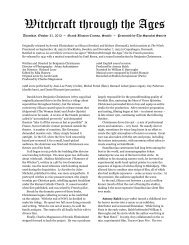Experimental Memoria II: Robert Breer - The Sprocket Society
Experimental Memoria II: Robert Breer - The Sprocket Society
Experimental Memoria II: Robert Breer - The Sprocket Society
Create successful ePaper yourself
Turn your PDF publications into a flip-book with our unique Google optimized e-Paper software.
This Evening’s Program<br />
All films shown in their original 16mm format. Prints courtesy of <strong>The</strong> Film-makers’ Cooperative (NY).<br />
<strong>The</strong>re will be a brief intermission.<br />
Viewer Advisory: Many films in this program include or consist of very rapidly changing and<br />
stroboscopic imagery. This may adversely affect those with photo-sensitivity.<br />
Part 1: One Man Show (1966)<br />
Color & B/W, 50 min.<br />
An anthology apparently prepared by the Film-makers’ Cooperative, though it is unclear to what extent<br />
the director may have played a role in the selection. It contains the following seven films:<br />
Jamestown Baloos (1957) color & b/w, sound, 6 min.<br />
Award: Bergamo International Film Festival<br />
“<strong>Breer</strong>’s early masterpiece is a three-part film that combines animation and live-action, collage and<br />
photography, silence and sound.” – Harvard Film Archive<br />
“Jamestown Baloos is a frenetic, three-part stop-motion animation that features an army of<br />
everyday forms and figures — geometric shapes, a piece of string, newspaper clips, a pin-up girl, even<br />
Napoleon Bonaparte — flashing across the screen. Placed in increasingly compromised situations<br />
and choreographed to a jingoistic tune, the figures essentially become puppets of their former selves.<br />
Such unrelenting visuals recall not only Fernand Léger’s early experimental film, Ballet Mécanique<br />
(1924), as <strong>Breer</strong> himself has mentioned, but also early twentieth-century Dadaist collage. Dada<br />
artists like Kurt Schwitters and Hannah Höch created witty, unapologetic works that reflected the<br />
chaos and violence of modern existence. Jamestown Baloos serves, as their works did, as a pointed<br />
indictment on the absurdity of war.” – Kelly Shindler, Assistant Curator, Contemporary Art Museum<br />
St. Louis.<br />
“Jamestown Baloos, I felt, was a turning point. It was a breakthrough for me. …I think<br />
Jamestown Baloos was a film where I felt I was riding kind of high on that film and mixed in<br />
everything, every discipline I could think of, very conspicuously, and would carry it off just on the<br />
level of drive and euphoria, and it would work because I’d will it to work, that’s all.<br />
“It was a triptych. And I was actually thinking in terms of the triptychs that I had seen, I guess,<br />
in Germany. You know, they fold, they close, and I think there is one in a Northern German town<br />
(Lubeck), in a big church there...I don’t know whose it is, maybe a medieval German artist – it’s black<br />
and white on either side and color in the middle, and this was, I think, the basis for making<br />
Jamestown Baloos that way. Three parts. <strong>The</strong> color is silent, and the other two parts have sound on<br />
them. <strong>The</strong> idea was that it’s a completely symmetrical piece of film, it has no real beginning or end,<br />
you could close the black and white things in...I think of the films as objects sort of, rather than<br />
continuities. You should be able to hold them upside down. But that is not true, you can’t show<br />
them backwards, it wouldn’t make any sense...I think of them as blocks of time, in which no time<br />
takes place.” – R.B. interviewed in Film Culture no. 56-57 (1973)



